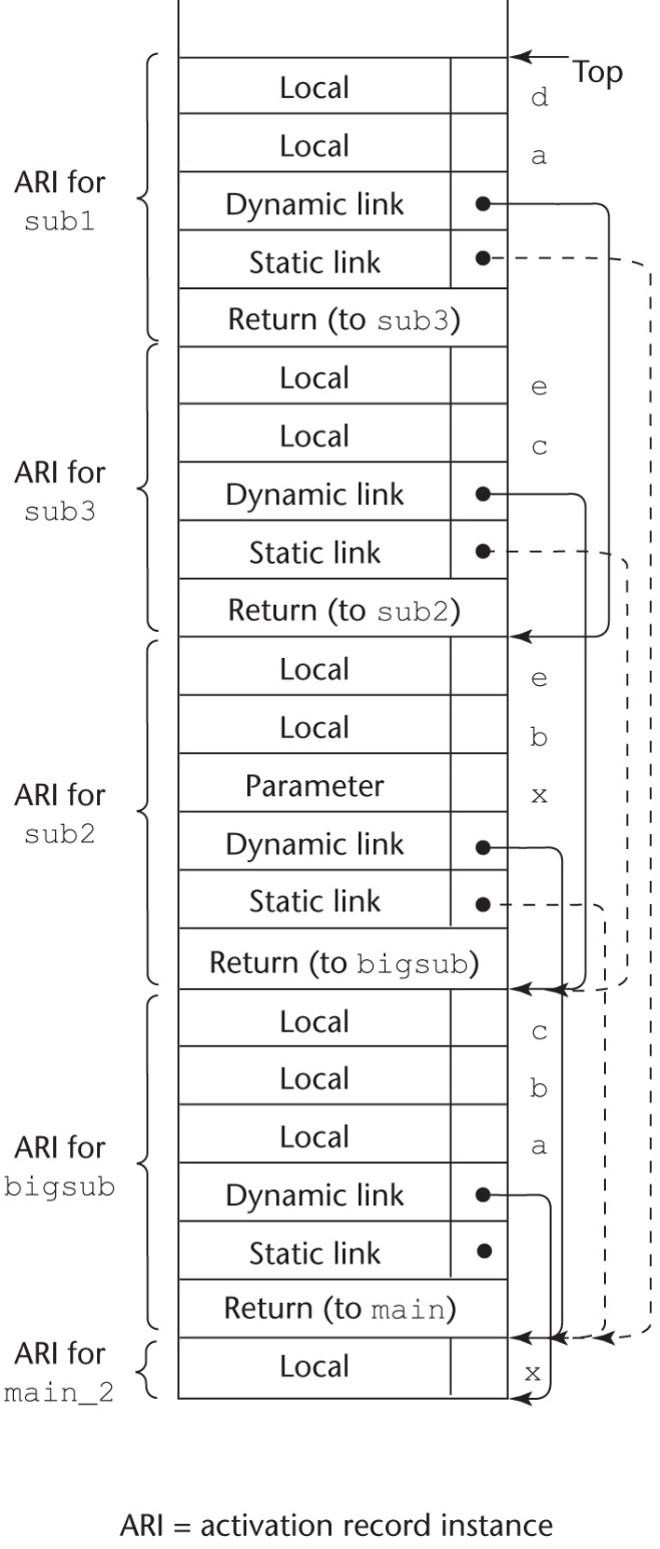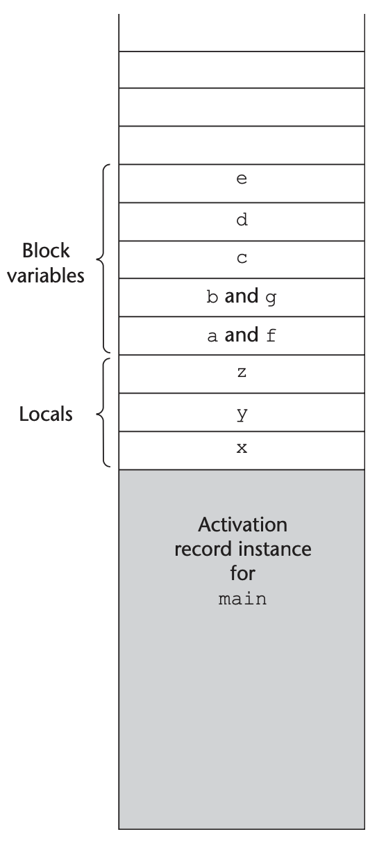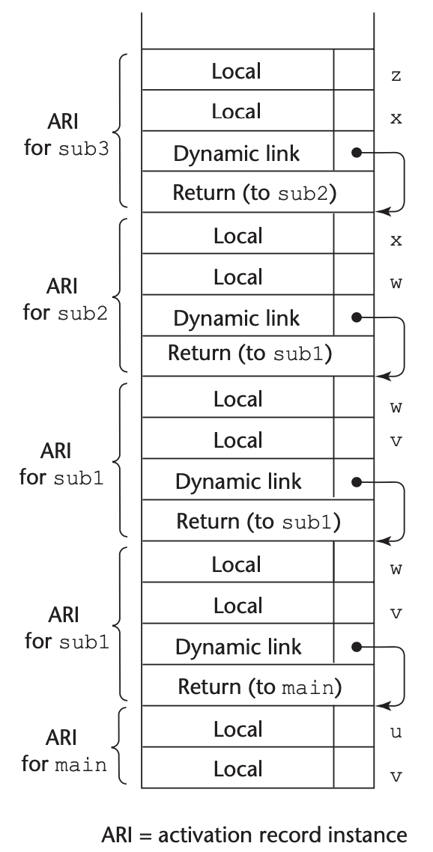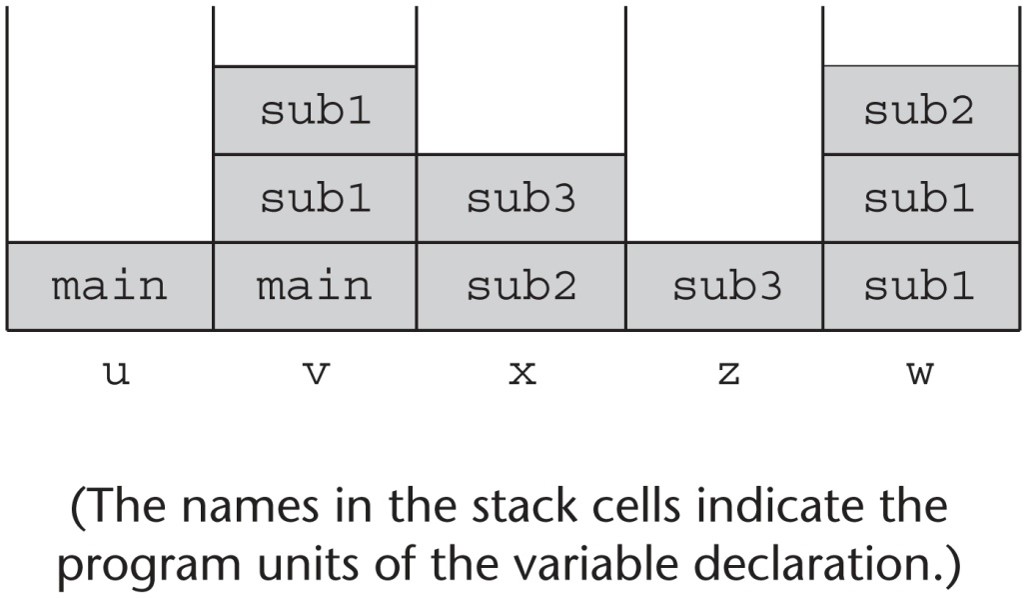16 - Subprogram Implementation#
Nested Subprograms#
Some non-C-based static-scoped languages (e.g. Fortran 95+, Ada, Python, JavaScript, Ruby, and Swift) use stack-dynamic local variable and allow subprograms to be nested.
All variables that can be non-locally accessed reside in some activation record instance in the stack.
The process of locating a non-local reference:
Find the correct activation record instance
Determine the correct offset within the activation record instance
Locating a Non-Local Refernce#
To find the correct activation record instance:
Static semantic rules guarantee that all non-local variables that can be referenced have been allocated in some activation record instance that is on the stack when the reference is made
Static Scoping#
A static chain is a chain is a chain of static links that connects certain activation record instances.
The static link is an activation record instance for subprogram A points to the activation record instance of an activation of A’s static parent.
The static chain from an activation record instance connects it to all of its static ancestors.
Static_depth is an integer associated with a static scope whose value is the depth of nesting of that scope.
The chain_offset or nesting_depth of a nonlocal reference is the difference between the static_depth of the reference and that of the scope when it is declared.
A reference to a variable can be represented by the pair (chain_offset, local_offset), where local_offset is the offset in the activation record of the variable being referenced.
Example in JavaScript:
function main() {
var x;
function bigsub() {
var a, b, c;
function sub1() {
var a, d;
a = b + c;
}
function sub2(x) {
var b, e;
function sub3() {
var c, e;
sub1();
e = b + a;
}
sub3();
a = d + e;
}
sub2(7);
}
bigsub();
}
Note that main calls bigsub, which calls sub2, which calls sub3, which calls sub1.

Static Chain Maintenance#
At the call,
The activation record instance must be built
The dynamic link is just the old stack top pointer
The static link must point to the most recent ARI of the static parent
There are 2 methods:
Search the dynamic chain
Treat subprogram calls and definitions like variable references and definitions
Problems with the evaluation of static chains:
A nonlocal reference is slow if the nesting depth is large
Time-critical code is difficult:
Costs of nonlocal references are difficult to determine
Code changes can change the nesting depth, and therefore the cost
Blocks#
Blocks are user-specified local scopes for variables.
An example in C:
{int temp;
temp = list[upper];
list[upper] = list[lower];
list[lower] = temp;
}
The lifetime of temp in the above example begins when control enters the block.
An advantage of using a local variable like temp is that it cannot interfere with any other variable with the same name.
Implementing Blocks#
There are 2 methods for implementing blocks:
Treat blocks as parameter-less subprograms that are always called from the same location.
Every block has an activation record; an instance is created every time the block is executed
Since the maximum storage required for a block can be statically determined, this amount of space can be allocated after the local variables in the activation record
Implementing method 2:
void main() {
int x, y, z;
while (...) {
int a, b, c;
...
while (...) {
int d, e;
...
}
}
while (...) {
int f, g;
...
}
...
}

Implementing Dynamic Scoping#
Deep access: Non-local references are found by searching the activation record instances on the dynamic chain.
Length of chain cannot be determined statically
Every activation record instance must have variable names
Shallow access: Put locals in a central place.
One stack for each variable name
Central table with an entry for each variable name
Using deep access to implement dynamic scoping#
void sub3() {
int x, z;
x = u + v;
...
}
void sub2() {
int w, x;
...
}
void sub1() {
int v, w;
...
}
void main() {
int v, u;
...
}

Using shallow access to implement dynamic scoping#
This uses the same code snippet as the previous example:

